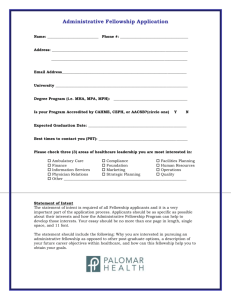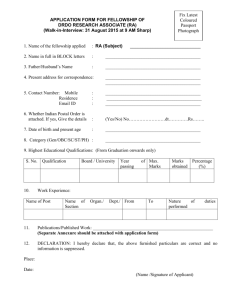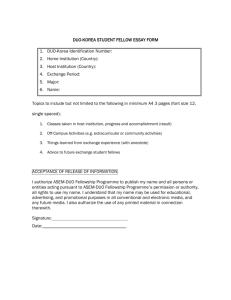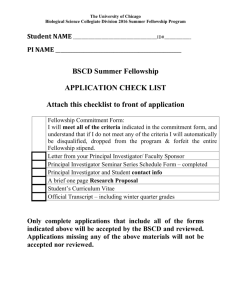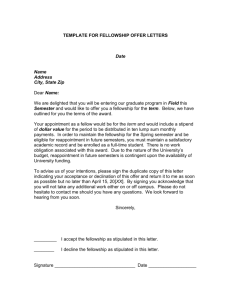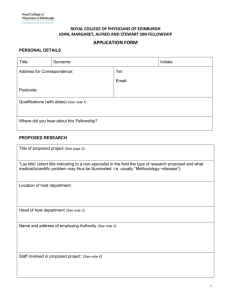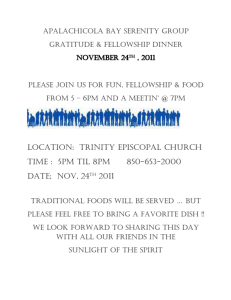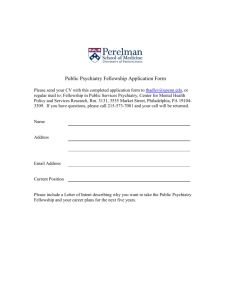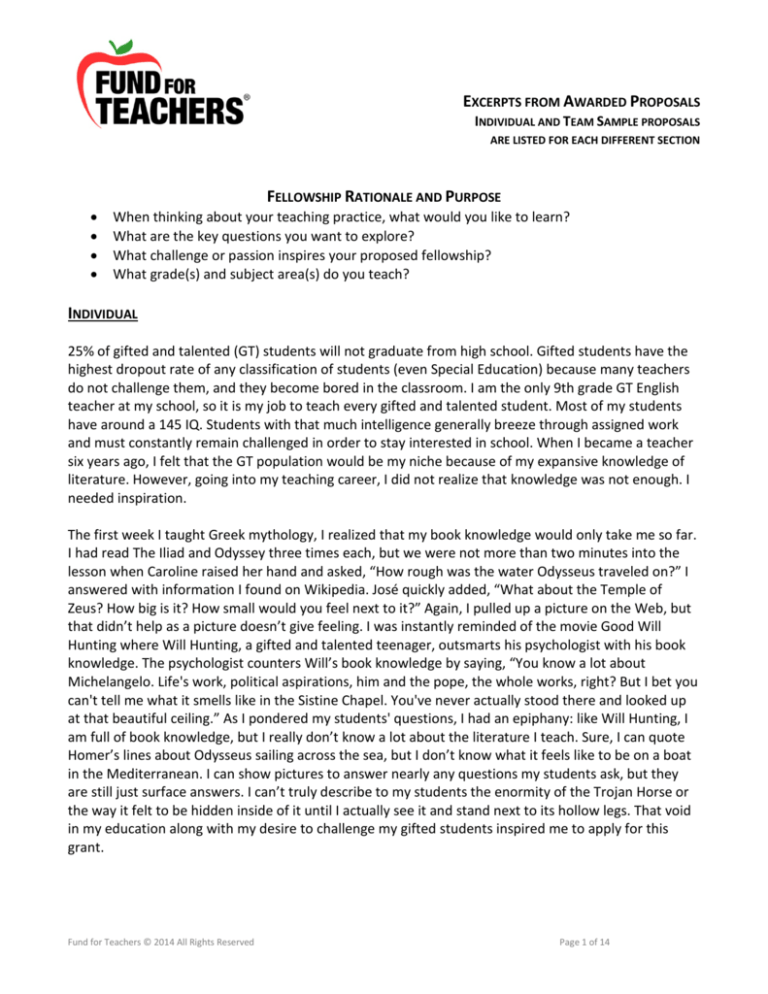
EXCERPTS FROM AWARDED PROPOSALS
INDIVIDUAL AND TEAM SAMPLE PROPOSALS
ARE LISTED FOR EACH DIFFERENT SECTION
•
•
•
•
FELLOWSHIP RATIONALE AND PURPOSE
When thinking about your teaching practice, what would you like to learn?
What are the key questions you want to explore?
What challenge or passion inspires your proposed fellowship?
What grade(s) and subject area(s) do you teach?
INDIVIDUAL
25% of gifted and talented (GT) students will not graduate from high school. Gifted students have the
highest dropout rate of any classification of students (even Special Education) because many teachers
do not challenge them, and they become bored in the classroom. I am the only 9th grade GT English
teacher at my school, so it is my job to teach every gifted and talented student. Most of my students
have around a 145 IQ. Students with that much intelligence generally breeze through assigned work
and must constantly remain challenged in order to stay interested in school. When I became a teacher
six years ago, I felt that the GT population would be my niche because of my expansive knowledge of
literature. However, going into my teaching career, I did not realize that knowledge was not enough. I
needed inspiration.
The first week I taught Greek mythology, I realized that my book knowledge would only take me so far.
I had read The Iliad and Odyssey three times each, but we were not more than two minutes into the
lesson when Caroline raised her hand and asked, “How rough was the water Odysseus traveled on?” I
answered with information I found on Wikipedia. José quickly added, “What about the Temple of
Zeus? How big is it? How small would you feel next to it?” Again, I pulled up a picture on the Web, but
that didn’t help as a picture doesn’t give feeling. I was instantly reminded of the movie Good Will
Hunting where Will Hunting, a gifted and talented teenager, outsmarts his psychologist with his book
knowledge. The psychologist counters Will’s book knowledge by saying, “You know a lot about
Michelangelo. Life's work, political aspirations, him and the pope, the whole works, right? But I bet you
can't tell me what it smells like in the Sistine Chapel. You've never actually stood there and looked up
at that beautiful ceiling.” As I pondered my students' questions, I had an epiphany: like Will Hunting, I
am full of book knowledge, but I really don’t know a lot about the literature I teach. Sure, I can quote
Homer’s lines about Odysseus sailing across the sea, but I don’t know what it feels like to be on a boat
in the Mediterranean. I can show pictures to answer nearly any questions my students ask, but they
are still just surface answers. I can’t truly describe to my students the enormity of the Trojan Horse or
the way it felt to be hidden inside of it until I actually see it and stand next to its hollow legs. That void
in my education along with my desire to challenge my gifted students inspired me to apply for this
grant.
Fund for Teachers © 2014 All Rights Reserved
Page 1 of 14
Homer began the Odyssey with the following line, “Sing in me, Muse, and through me tell the story of
that man skilled in all ways of contending…” In essence, Homer asked the Muses to send him
inspiration to tell the story of Odysseus. How fitting it is that Homer asked for inspiration, not
knowledge. The details of the story were simply not enough for him. They are no longer enough for me
either. My teaching practice up to this point has revolved around gathering as much knowledge as
possible. My rationale for taking this trip is that I, like Homer, must be inspired. My goals are twofold.
First, I want to fully understand the journey of Odysseus, the obstacles he encountered, and how
Greek Mythology has impacted modern Greece and the traditions of Greek Culture. In other words, I
want to travel in Odysseus’ footsteps from Greece to Turkey to the islands of the Mediterranean so
that I can experience the world as he did, while immersing myself in the traditions of Greek society.
Second, I want to use the knowledge I gathered to bring the Odyssey to life in my classroom so that I
can challenge my GT 9th graders.
Homer also said, “It is tedious to tell again tales already plainly told.” The story of The Odyssey speaks
for itself, and gifted 9th graders are more than capable of reading it on their own. I have taught it for
six years, and I am tired of retelling it. I want to be so inspired from my trip that my experiences flow
over into all of my daily teachings. When I wake up each morning, I want to feel reinvigorated because
I know I have something new and exciting to share. Most importantly, I want to enrich minds by
providing a front row seats to the most epic tale of all time. My passion is to ensure that all of my
gifted students graduate from high school. To do this, I must inspire them as the Muses inspired
Homer. This journey will enable me to do so.
TEAM
How can we maximize math achievement in an environment of heightened accountability without
over-relying on high stakes standardized tests, which can dilute curriculum and impede real learning?
We will research how to do it in the country that does it best, Finland.
We have been teaching math a combined 16 years. In that time, we have each sought to constantly
expand our practice, to develop professionally, and to make our subject come alive for our students.
Both of us have taught traditional math curriculum to historically under-performing students and
experienced great success moving students to more advanced levels of understanding. Many of our
students have had very good results on standardized tests and gone on to pursue math related fields in
college. However, too many students in the current system become discouraged in their education and
don't reach their full potential. To address this issue, we have been honored as teachers to have
opportunities to develop unique curriculum. From topics as broad as using trigonometry in forensics
labs to uncover crime scenes, to student generated data sets to analyze social justice issues in our
community using statistical methods from the social sciences, we've been challenged to walk the line
between test preparation and creative, relevant, rigorous math curriculum to engage all learners.
As recent education reform has more than ever reduced education to students' performance on high
stakes standardized tests, this line has gotten exceedingly difficult to walk. However, with the
transition to the new Common Core State Standards in 2013, which 45 states, including New York, have
Fund for Teachers © 2014 All Rights Reserved
Page 2 of 14
pledged to adopt, we are confronted with an invaluable opportunity for positive reform. This Fund for
Teachers fellowship will be an opportunity to develop new strategies to promote student growth and
to position us to be leaders in our math department, school, and at the network level in implementing
concrete classroom practices and curriculum that reflect the learning objectives and educational values
of the new Common Core State Standards. Throughout the fellowship we will be using Finnish schools
as a lab to research best practices for maximizing secondary math learning to reach all of our students.
In international measures of secondary school math achievement (Program for International Student
Assessment, PISA), several countries consistently score at the top of the list. Most of these countries
have educational systems that stress rote learning, test preparation, and extreme competition. Though
these countries' educational systems foster many of the highest performing students in the world, they
also have huge achievement gaps between successful and unsuccessful students. This type of disparity
is one the United States cannot continue to perpetuate.
There is however one country that distinguishes itself from the rest of the world in this regard. Finland,
rather than emphasizing competition and high stakes testing, values equity, creativity, and efficiency,
and still is among the top three performing countries on the PISA. In fact, although Finnish students
don't start school until the age of seven, have a shorter school year, less homework, and don't take any
standardized tests until their last year of high school, they outperform other countries, including the
United States, by leaps and bounds. We plan to learn how they do it so that we can replicate best
practices, share them with our colleagues, and advocate for effective policies back home.
•
•
•
PROJECT DESCRIPTION
Describe and outline in detail your proposed fellowship.
What key activities will you pursue, and why are they important?
What is the time frame for achieving the goals outlined in the rationale and purpose?
INDIVIDUAL
The main focus of my project will be to explore the individual cultures and settings that these authors
have used to create their voice. Each author has found a way to incorporate distinct monuments,
aspects of their language, cuisine, and custom in order to define a culture and create a voice for their
country. I want to document each country by creating a short film that can be uploaded to our class
website. Each video will allow the student to further engage with the book, poem, or short story. I will
video all interviews, including footage from current authors, local authorities and historians, as well as
educators who are also teaching these same texts.
I will begin my trip in St. Petersburg, Russia at the Stray Dog Café, a popular hangout for Russian poets
and artists where the likes of Anna Akhmatova have gathered in the past. I then want to follow the
Fund for Teachers © 2014 All Rights Reserved
Page 3 of 14
exact path laid out in Andrey Bely’s novel “Petersburg” who uses the city symbolically throughout the
entire text. I will visit the Hermitage museum and meet with the curator in charge of the Dostoyevsky
archives. I will visit “The Bronze Horseman” which was used by both Dostoyevsky, and most famously
Pushkin as a symbol of the political environment in St. Petersburg. I will also travel outside of the city
to the town of Pushkin, a small suburb renamed by the Soviets as a way of creating ownership for the
poet. I will visit the RCC Pushkin School where educators teach the poetry of Pushkin as a mandatory
part of their curriculum and explore how it plays a part in their national identity. I will later compare
this with the school programs offered at the Pushkin Academy in the US that offers similar instruction
for students of all ages. I will also attend a opera performance inspired by Pushkin at the Maryinski
Opera House, as well as a performance at the Bolshoi Theater House.
I will next travel to Riga, the capital of Latvia where I will take part in a writing course at the Latvian
Literature Center conducted by a working author and poet, Inga Gaile. I will explore how Regina Ezera
used small towns outside of Riga as the symbolic backdrop for her novel, “The Smoldering Fire,” and
how the characters use monologue to hint at the tragic events in their countries past. I will also visit
the Museum of Occupation of Latvia, as well as the Freedom Monument.
Next is Lithuania, home of the House Museum of the Venclova Family. His works of fiction explore his
experiences working toward independence, most vividly seen in “Forms of Hope.” I will also visit the
Hill of the Crosses, the Devil’s Museum, and the Ninth Fort, all that play an active role in Venclova’s
collected poems, “The Junction.” I will also conduct a home stay arranged through the cultural center
that will allow me to take part in every day life for a Lithuanian family.
I will next travel to Minsk, Belarus which is often referred to as the “city of dead poets” or “the sun city
of dreams,” which Artur Klinov used as the title of his work. I will take part in the historical walking tour
that shows how the capital was the backdrop for a great deal of uprising during the revolution. I will
visit the Khatyn Memorial and the Victory Square. I will attend a free workshop at the Yakub Kolas'
Memorial and Literary Museum. Kolas’s poem “The Fisherman’s Hut” is a testament to the battle that
occurred after unification of Belarus and the Soviet state. There is also a documentary that follows
author Valzhyna Mort on how she is determined to continue writing in her national language as a
means of sustaining it for a new generation. I will document the settings she uses in her first book, “A
Factory of Tears,” and create a visual road map for my students using film and photography.
My final stop will be Kiev, Ukraine where I will visit the Great Patriotic War Museum, a one of a kind
facility that offers a Soviet perspective on the war with a vast supply of artifacts, documentaries, and
primary sources that can be taken back into the classroom. I will also visit the Rodina Mat and the
Maidan Nazalezhnosti, monuments that have been inspiration for the Ukraine’s independence. I will
visit the National Taras Shevchenko University of Kyiv where I will meet with Professor Andriy
Horbachyk who uses the short story “The Moscoviad” by Yuri Andrukhovych as part of his sociology
curriculum. I will attend his summer lecture course where he discusses how this text created an
identity while simultaneously mocking the Soviet methodology of society. I will conclude my journey in
a similar fashion to how it all began; with a free verse poetry night at the Jules Verne coffee shop in the
heart of Kiev. In total, I will be spending 18 days, leaving New York on Aug 1st, and returning on Aug
19th.
Fund for Teachers © 2014 All Rights Reserved
Page 4 of 14
TEAM
“We as a people have to move from a culture of consumption to a culture of conservation, a culture of
consumers to a culture of producers of renewable energy. We have no time left for half measures.”
Paul Gipe, author, advocate and renewable energy analyst succinctly encapsulated the dilemma we
face today.
One of the most reliable of the renewable energies today, and the one that the International Energy
Agency (IEA) predicts will be most cost efficient by 2035, is wind. Most of America's wind power is
collected in Texas, which provides more than 25 percent of the country's wind-generated electricity.
There is hydro-electrical energy, biomass, solar, geothermal energy as well as nuclear. In searching, we
could not find either a biomass or geothermal production of any real substance in the United States,
nor the dedication to most of the other renewable energy options to the degree that we have found in
Scandinavia. We have purposefully omitted nuclear energy due to these concerns: controversial
nature, ambiguity of its renewability and limited community input due to governmental involvement.
We propose taking our search for answers abroad, to globally recognized, successful facilities in
Iceland, Norway, Denmark, and Sweden. These four countries are leading the way in the use and
development of renewable resources. We want to examine first-hand how these countries are
successfully using these energies to limit their carbon footprints, and maintain a strong renewable
energy initiative in the process. We will also look into how this recognized commitment factors into the
daily life and culture in each country. Unlike ours, they use substantially more renewable energy than
we do. We will come away with an understanding of the type of commitment it will take to become
less dependent on nonrenewable energy sources in the future.
For our fellowship, we will collect primary source data in these forms: personal interviews, touring of
model “zero carbon footprint” communities, visiting energy-based museums, and touring 4 alternative
energy facilities. We will immerse ourselves in a proactive renewable environment for three weeks as
we travel through Scandinavia from June 5th through June 24th.
First stop is Iceland, with a look at geothermal energy and exploration of some of the best-known
natural phenomena, including Þingvellir National Park and the Great Geysir area on a day-long guided
tour of the geographic area called the Golden Circle. We will tour the Geothermal Energy Exhibition at
Hellisheiði Power Plant for a state-of-the-art look into the harnessing of geothermal energy. We finish
up at the Blue Lagoon, which features geothermal heated pools of seawater surrounded by actual lava
fields and black beaches. The next leg of the tour is Norway where we explore hydroelectric energy at
the Sima Power plant located outside Bergen. A guided tour of the plant will help us document the
process involved. In Oslo we will interview students at Ruseløkka skoles, a local elementary school,
Marianne Butenschøn, a local historian and Petter Heyerdala, a professor of the Norwegian University
of Life Sciences, who also lectures high school students on energy conservation. By adding personal
insights to our documentary, we hope to show the impact these resources have had on the culture and
lifestyles of the citizens. We will conclude our stay with a visit to the Norway Technology Museum
where they have a quality renewable energy exhibit. In Sweden, solar energy is the focus on a tour of
the Solar Region Skåne Cooperation in Malmö— an international role model for its use of solar energy
Fund for Teachers © 2014 All Rights Reserved
Page 5 of 14
to learn about installations of photovoltaic and solar collectors. From Sweden we go to Denmark to
explore wind and biomass energy in Copenhagen, a premier global environmentally friendly city. Next
is Middlegrunden, one of the largest wind farms in Denmark, and onto the country’s largest biogas
plant in Lemvig. This plant collects slurry from farms and industrial waste to produce heat and power.
The Tvind Wind Turbine Test Center and the Nordic Folk Center for Renewable Energy, a showcase of
all forms of renewable energy, will also be toured. A trip to Samsø Island, which is 100% self-sufficient
through wind-generated electricity and an award-winning city for innovations in renewable energy, will
complete our journey. Interviews will be collected in each of the different locations to gather primary
source information on the impact of energy resources.
•
•
•
TEACHER GROWTH AND LEARNING
How will your fellowship help you address your key questions and/or learning goals?
How will this fellowship help you grow as a teacher?
How will the new proposed learning inform the content you currently teach?
INDIVIDUAL
It is difficult for all teachers to fully comprehend their practices and the assumptions these practices
grow out of until they are confronted by different contexts and radical alternatives. As the designer of
a brand new music program, this difficulty goes double for me: I am constantly immersed in my own
vision, my own understanding of the community I work with, and the immediacy of my daily
interactions with students. I am well aware that my work is limited by my own experiences, all of which
come from U.S. music education traditions.
This fellowship is an opportunity to see my work through new eyes. The life and language of El Sistema
are a hemisphere away. Yet it shares with me the work of responding to poverty through music
education, the same instruments and much of the musical literature I teach, and a passion that the
work we do is not simply to teach music but to shape communities and change lives. To interact with El
Sistema and document the ways its participants respond to their communities’ needs is to open myself
to a revision of my own work as a teacher. And it is from this interaction that I look to push my thinking
on the role of music education as a response to impoverished communities, and consider broadly how
it can better serve youth in this global world.
Secondarily, this fellowship provides a unique opportunity to work with students in Venezuela as a
guest music educator, alongside El Sistema’s teachers. I know that my weaknesses as a teacher include
my work with students whose second language is English, and my ability to connect culturally and
musically with many of my students of Latin American descent. This opportunity to travel to South
America for the first time, and as a teacher rather than a tourist, assures a depth of immersion into the
rich cultural life many of my students come from.
Fund for Teachers © 2014 All Rights Reserved
Page 6 of 14
TEAM
As educators we have discovered that becoming passionate about topics we teach greatly impacts our
effectiveness. It is for this reason that we actively seek opportunities that will kindle our passion and
light a spark to propel us into our classrooms to make even more meaningful learning experiences for
our students. It is also for this reason that we continually reflect upon our teaching. Reflection is that
crucial element that oftentimes involves stepping out of our comfort zones, shifting our thinking, or
pursing bigger and more innovative methods. Our fellowship in Acadie will allow us to step out, shift,
and pursue by thrusting us into an environment where we will have to overcome language barriers,
drive in unknown territory, use foreign currency, and work as a documentary production team to
accurately and adequately document our experiences. We are convinced that this fellowship will be
the spark that increases our enthusiasm for teaching our history unit and stimulates our instructional
creativity as we seek to learn all that we can, see all that we can, do all that we can, and go everywhere
we can go in the short amount of time we have in Acadie.
We will also gain a perspective of the Acadian story that we would not have had otherwise without this
opportunity. Our content knowledge will increase exponentially through our hands-on encounters in
authentic settings, meaningful discussions with experts, and interactions with Acadians in their natural
surroundings. This wealth of experiences and increased frame of reference will allow us to have an
extensive repertoire of knowledge from which to base content-rich lessons.
•
•
STUDENT GROWTH AND LEARNING
How will students benefit from your proposed fellowship?
What meaningful additions will this experience bring to your classroom?
INDIVIDUAL
Part of the mission of the Multilingual Department is to “promote English Learners’ languages,
cultures, and experiences as the foundation for new learning and success in a global, knowledge-based
economy.” This commitment, when it is achieved, results in the best possible learning for students
because it is individualized, respectful, and meaningful. When a student’s background becomes the
basis for learning, the learning sticks. Though my primary job is as a teacher of English as a Second
Language, this project will impact more than just English language proficiency; students will benefit
from more culturally aware classroom teachers and an inviting, appreciative school environment.
Students in my own classroom will be better served by my expanded ability to connect with them, by
activating their prior knowledge and by using culture and personal experiences as a foundation for
English learning.
With the answers to my guiding questions I will be able to engage students by having an authentic
connection with them; I will be able to access prior knowledge that will help them understand core
content as they learn English; I will be able to aid classroom teachers by informing them of what to
expect in terms of language and culture. For example, students will be able to improve their English
Fund for Teachers © 2014 All Rights Reserved
Page 7 of 14
writing skills by writing personal narratives that describe life experiences in their home country; my
firsthand experience in their culture will enable me to focus their writing with more precise English
vocabulary and forms, prompt them for more varied and vibrant details, and build a knowledgeable
audience that is ready and eager to learn about their classmates’ life experiences. All students will
benefit from the learning gained through this project.
TEAM
Students will benefit from this fellowship because they will learn responsible, productive ways to meet
their own emotional needs. As behavior disruptions occur, students will learn to categorize their own
behavior into the appropriate category, and learn resolutions specific to their individual situation.
While we cannot change the circumstances from which they have come, we can give them the tools
necessary to overcome academic and emotional hardships. As teachers we have a fantastic
opportunity to increase their self-esteem, self-concept and self-worth. This will benefit them inside and
outside of the school setting. They will be able to successfully identify their problem and a resolution
that will not interfere with classroom learning. We will keep a log of behavior disruptions for our own
students, so that they can view their progress over time as the number of incidents decreases. As
students practice this process with the teacher inside the school setting, they will be able to use
these strategies independently outside of school. Students who do not exhibit negative behaviors will
benefit because their learning time will not be disrupted by others, thereby increasing time on task.
Academic achievement of all students will increase due to an increase of academic learning time and a
decrease in behavior disruptions.
This experience will be invaluable to our classrooms. Research proves that students learn better in a
comfortable, positive environment. Research also proves that students whose emotional needs are not
met express themselves with negative, disruptive behaviors, and have low academic achievement. By
utilizing the strategies of Win-Win Discipline, our classrooms will be more comfortable and positive for
all students, as well as more productive learning environments. As our students learn how to resolve
their individual situations and emotional needs in a responsible,
productive fashion, their disruptive behaviors will decrease and their academic achievement will
increase. They will no longer need to call attention to themselves through negative behaviors. Most
importantly, they will learn necessary life skills that will enable them to be positive and productive
members of the community.
•
•
BENEFITS TO SCHOOL COMMUNITY
How will your fellowship experience contribute to your school community’s efforts to engage
students and improve learning?
How will you share the fellowship learning with colleagues?
INDIVIDUAL
Lifelong lessons, beyond the state tests, are a natural and foreseeable learning outcome for my
students. While the basic idea of expanding organic gardening lessons or introducing outdoor learning
Fund for Teachers © 2014 All Rights Reserved
Page 8 of 14
concepts into life science curriculum is simple, the ultimate results would be far more complex. The
idea, once it is established in my classroom, is to take it school-wide and beyond. My students mentor
5-year-olds through a Kinderbuddies program, and research proves that students learn even better
when trying to teach others. I see this as a serendipitous dual learning opportunity passing from my
classroom to other grades. From here, continuing beyond the schoolyard, and into the child’s home,
containerized gardening becomes the ultimate interactive project! I envision extended opportunities
for students to initially learn and experience things themselves at school, share with other students,
then go home and share with their families. It is important for children to understand and see the
benefit of what they are learning, producing and contributing to their home and community. I also
want to do this in such a way that it is not a chore for the families, but an intriguing experiment they
will enjoy continuing over time.
As a teacher, I notice families involved with their children’s learning produce better, more motivated
students. This project inherently encourages parental involvement and supports the child’s learning at
home without being financially burdensome.
Since the state curriculum requires so many learning objectives that directly tie to the concept of life
cycles, growth and the planning thereof, this gardening program can prove an optimal way for teachers
to cover several at once. Regular PLC (Professional Learning Collaborative) sessions with colleagues are
held on our campuses for presenting, sharing and explaining new curriculum ideas. These are ideal
venues for demonstrating how multiple content areas can be logically integrated into instruction and
spreading my enthusiasm to colleagues.
TEAM
This fellowship will provide exceptional opportunities for enhancing: professional development among
our staff; connections among students across grade and placement levels; initiatives on our mission
team; and interactions with students’ families.
Through collaborative efforts with our curriculum teams and Special Education colleagues, we are
aware the academic expectations of our school can restrict students with special needs. Consequently,
our struggling readers and writers have very little time for creativity and forms of self-expression. For
our students with Autism, this focus limits opportunities for inclusion and peer interaction. Resultant
to this problem, our students miss the chance to see that there is value in creative expression. Sadly, it
is those exact experiences that provide opportunities for students to connect their experiences to
others. We can alleviate part of this discrepancy because we will return with understanding and skills
that will help our co-teachers embed these needed skills into their existing coursework. We currently
have the professional development time allotted in our schedule; we simply need the fellowship to
provide us with the experience and knowledge.
In addition, our fellowship will benefit our entire student body because we will distribute the Personal
Narrative Anthology throughout the school. The collection of these memoirs, presented in various
media forms, will creatively express feelings of being isolated or different. Through the risks taken by
our students, all students at our school will have access to eye-opening stories to which they can
relate. Within these leadership roles, our students’ growth will benefit their peers either by helping
Fund for Teachers © 2014 All Rights Reserved
Page 9 of 14
them understand there are teens to whom they can relate, or by teaching them what it is like to feel
like an outsider.
Our school’s mission team will also benefit from our fellowship because we are both members. As
volunteers on this 5-member committee, we dedicate 3-5 hours/week towards developing leadership
education for our community. Sharing our risk-taking experiences and skills will aid our productivity as
a team, and facilitate our efforts to give all students the confidence and skills to be agents of change.
Additionally, our newfound creative techniques will assist our team’s task of expanding and changing
perceptions among staff when we propose school-wide initiatives.
Many of our students’ families will also benefit from our fellowship because our participation in the
Spanish immersion will improve our ability to communicate through advanced Spanish skills. Also, we
will also gain an approximate insight into the experiences of being thrust into a foreign environment.
With this understanding, we will be able to better create ways to make parents more comfortable
being part of the school community. We also plan to continue our Spanish studies to continue these
efforts.
PLAN FOR FELLOWSHIP IMPLEMENTATION OF LEARNING
Please outline a plan for implementing learning from your proposed fellowship within your classroom
or school. We are aware that unintended learning experiences may constitute powerful aspects of your
fellowship, so that not all valuable learning and transfer can be predicted. We do feel, however, that
planning clear structures for bringing fellowship learning back to students can contribute to a more
focused and significant experience in the field. Your implementation plan may be (1) an outline of a
newly created or enhanced curricular unit/project; or (2) an action plan for new classroom or schoolwide structures that you hope to implement.
(1) Curricular Unit/Project Outline: Focus on goals, student skills, general content, teaching methods,
student outcomes, evidence of student learning and assessment ideas.
(2) Action Plan: Focus on the goals, strategy, evidence of student learning and outcomes for new
classroom or school-wide structures.
INDIVIDUAL
If awarded a Fund for Teachers Fellowship, I will plan and implement new lessons in grammar, prose
and poetry. With my new-found fluency in Spanish, I will develop a new plan for teaching grammar
using my learning abroad and my continuing education here. I will also use my journals, reflections on
the emotional process of an immersion setting, to better teach favorite works like “How the Garcia
Girls Lost Their Accents.” Finally, with my Spanish that the fellowship has allowed me to acquire, I will
develop a new way of teaching poetry. Allow me to present the preliminary ideas on how I think the
poetry lesson will unfold.
Poetry without Borders
Fund for Teachers © 2014 All Rights Reserved
Page 10 of 14
Objectives
1. The students will know how to interpret a poem in English and evaluate its literary devices, musical
devices, figurative language, form and rhyme pattern.
2. The students will interpret poems from different languages in both their original language and its
English translation and will be able to evaluate them for all the same qualities afore mentioned.
3. The students will be able to compare and contrast the poems and identify the affect of language on
poetry.
Background
1. The students will be able to read and explicate a poem in English.
2. The students will be able to identify literary devices: metaphor, simile, symbol, image, flashback;
musical devices: assonance, alliteration, alliteration, onomatopoeia; form: rhyme pattern, meter,
stanza and refrain.
3. The students will be able to explain the affect of the literary devices on interpretation and lyrical
quality of a poem.
Activities
After I have modeled the “Activities” with several poems in Spanish with its English translation, I will
put the students in groups. At least one member of each group will be literate in a foreign language.
The school I teach at allows me this opportunity. In reviewing my classes, there are at least four
different languages other than Spanish in each of my five classes.
1. Translate the poem into English.
2. Identify all the figurative language: metaphor, simile, symbol etc.
3. Identify the meter of the poem in its original language.
4. Identify the rhyme pattern of the poem in its original language.
5. Identify the musical devices (assonance, consonance etc) in its original language.
6. Identify any refrains.
7. Identify and form, especially if different than English.
After the students have practiced several poems, they will select another to present to the class.
Finally, after all the groups have presented, this lesson writing lend itself to several writing prompts for
the students to explore.
Compare and contrast poet’s use of standard poetry techniques.
What are the universal truths about poetry?
What is lost in the translation of a poem?
How does the actual “sound” of a language affect poetry in terms of musical devices?
How is rhyme pattern affected by language?
How is meter affected by language?
I realize that I know only a little and certainly more will be revealed. This unit will, as my other lessons,
evolve. I will also develop and implement a new grammar and literature unit described previously.
Fund for Teachers © 2014 All Rights Reserved
Page 11 of 14
TEAM
Our plan to implement what we gain from the fellowship involves the refinement and enhancement of
our Injustice and Justice in Society curriculum unit. We seek to create a more authentic learning
experience for our students by using what we document on our journey to bring South Africa to life. By
restructuring our curriculum, we can push our students deeper into relevant concepts and themes in
their own research. We also plan to collaborate with the honors class to share our combined
knowledge with the rest of the students and community in an interactive exhibition.
GOALS
Our overall goal is to bring to life a learning experience that for many students seems distant and
disconnected from their own realities. We want students to understand that the story of South Africa’s
struggle over apartheid is not only one of significant historical importance, but one that has essential
human lessons that can directly impact their own lives. Specifically, our goals are:
1. To incorporate our experience of South Africa into our teaching.
2. To deepen student understanding of the major themes and issues related to the history and defeat
of apartheid in South Africa, as well as the transition of post-apartheid South African society.
3. To have students show what they have learned by sharing their knowledge with the school
community.
4. To serve, ourselves, as a resource for our colleagues who wish to broaden their own curriculum, and
to our school community which seeks alternatives to traditional discipline.
STRATEGIES
In order to successfully accomplish these goals, we will:
1. Document and record our fellowship through multiple mediums.
2. Redesign our curriculum unit to include additional focus on Nelson Mandela, apartheid, and the
Truth and Reconciliation commissions.
3. Incorporate the experience of the South African people today into our teaching and expand on the
importance of traditions and cultural identity.
4. Utilize specific techniques used by South African exhibits in our teaching and in the design of student
products.
5. Structure student work towards researching the key themes and issues of historical, economic and
political significance in South Africa.
6. Design an exhibit with the class based on their research and our experience at the Apartheid
Museum in Johannesburg.
7. Meet, collaborate, and share with other faculty members.
8. Assist the school community in the implementation of the Restorative Justice model.
OUTCOMES
A year from now, we expect to have accomplished the following:
1. Students have learned, with depth and complexity, the history of South Africa’s apartheid era and its
emergence from it.
Fund for Teachers © 2014 All Rights Reserved
Page 12 of 14
2. Students have made connections between South Africa and other historic instances of injustice and
reconciliation.
3. Students and staff are deeply committed to reconciliation and its connection to our own program of
restorative justice. Student leaders understand the philosophical connections between the two.
4. Students use specific artifacts and information from our fellowship to further their own research.
5. Students will create an interactive, multi-media event that may be recreated every year to the
benefit of each new class and families that enter our school.
BUDGET NARRATIVE
Provide a brief narrative showing evidence of thoughtful planning and research into your specific
itinerary. The narrative should explain the rationale for the project's expenses. Be precise. Stipulate a
time frame and approximate costs as closely as possible. Include the resources used to arrive at your
final itinerary within the narrative. Costs should be realistic in relation to the proposed scope.
If including a technology expense specify: why the item is necessary for the fellowship's success, why
you have chosen the specific brand/type, and whether you have prior experience using the technology.
Food costs should reflect actual destination rates and not exceed $50 per day/per person.
INDIVIDUAL
Transportation Costs: These include roundtrip airfare, estimation of taxi and bike rental costs.
Roundtrip airfare determined via priceline.com from Cincinnati, OH to Barcelona, Spain ranged in price
from $1300-$1900. I selected a mid-range price of $1600. Taxi costs would only be needed from the
airport to the hotel which is a distance of approximately 8 miles. Taxi cost range in price from 1.5-1.8
euro's a kilometer which equates to $2-$4 a mile. For locations outside of walking distance I
researched bike rental fees. Mid-range cost for daily bike rentals equated to $25. Total=airfare
$1600,taxi costs $20,two days bike rental $50=$1670
Lodging is included within participation of workshop cost and includes creativity workshop
participation and single room lodging for eight nights beginning July 6th with check-out on July 14th.
Total tuition and lodging=$2675
Food allowance cost were estimated based on researching www.wikitravel.com and tourist sites
related to Barcelona, Spain. Prices were given in Euro's for several area eateries. Meals ranged in price
from a minimum of 5 Euro's per meal and a maximum of 25 Euro's per meal. This equates, at current
exchange rates to $7-$30. I estimated a median price of $15 per meal for three meals a day. This totals
$45 for nine days. Total food cost=$405
Materials and Supplies were determined by searching admission cost for various nature perserves and
museums that I anticipate visiting as well as the anticipated cost of artifacts and souvenirs. Most
admission costs were priced at 15 Euro's which equates to approximately $18 at current exchange
rates. To account for potential change in admission cost due to July being peak season, I have rounded
Fund for Teachers © 2014 All Rights Reserved
Page 13 of 14
this estimate to $20 per site. Three to four attractions could realistically be visited during a two day
free exploration period which equtes to a total of $80 admission cost. I've also included an extra $120
to purchase Spanish keepsakes and souvenirs. Total materials and supplies=$200
There is no extra equipment needed to purchase to implement learning acquired as a result of this
fellowship. Total cost for fellowship=$4,950
TEAM
We are proposing a trip between 7/16 and 8/03 and have budgeted for 19 days, including 48 hours of
air travel to and from Asia.
Airfare: We have budgeted $1,970 each for airfare. After searching several websites and investigating
different dates, we have found this to be the cheapest fare (orbitz.com), though prices have continued
to rise.
Transportation: We will travel through Japan and Korea using a combination of buses, trains, and ferry.
We have budgeted $47.16 each for a 3 day Korea rail pass and $363 for a 7-day Japan rail pass.
According to several travel guides, buying passes is the most cost effective way to travel due to how
often we will require transportation. The ferry to Japan is $168 per person, according to the ferry
company’s website. Additionally, we have budgeted $20 each for short bus trips in Korea.
Activities: We are requesting $750 each for our trek. Though somewhat expensive, it is important to
note that this fee includes all food and lodging for 5 days of our trip. It is also the most affordable
guided trek we were able to find online or in travel guides, and there is a possibility that the fee could
be reduced if more tourists join the trek. We are also budgeting $70 per person for the DMZ tour, $70
for the Celadon pottery workshop in Icheon, and $50 for the hanbok course in Seoul, as well as $100
for other museum and workshop fees (source: Lonely Planet Korea & Frommer’s Japan)
Food: We are budgeting for 14 days of food, as 5 days of food will be included in the all-inclusive
trekking fee. According to Lonely Planet Korea, budget meals cost approximately $7 each (plus nominal
charges for snacks and water). Thus we have budgeted $25 per day per person for the 8 non-hiking
days we will be in Korea, for a total of $200 each. Because Japan is a notoriously expensive country, we
have budgeted the full $50 per day, for a total of $300 each for our 6-day stay.
Accommodations: According to the Lonely Planet, mid-range hotels in Korea will cost about $54 a day,
for a total of $486. Japan is much more expensive, and we plan to mitigate these costs by booking an
apartment while in Kyoto for $141 a night (for a total of $634). Accommodations in Hiroshima and
Tokyo will likely cost approximately $195 and $260 per night, respectively, so we plan to spend only
one night in each of those cities. We recognize that Japan is an expensive country, and thus plan to
stay only six nights. We are currently looking into staying with acquaintances in Seoul, which could
further reduce costs.
Artifacts: Finally, we are requesting $100 each to bring back Celadon pottery and other cultural
artifacts from both Korea and Japan.
Fund for Teachers © 2014 All Rights Reserved
Page 14 of 14

